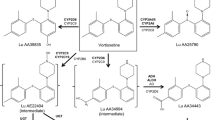Summary
Commercial preparations of the tricyclic antidepressant doxepin contain 15% of the more active cisdoxepin and 85% of the trans-isomer. The single dose pharmacokinetics of doxepin and its major metabolite N-desmethyldoxepin were examined in 30 healthy young men.
Results for total doxepin showed wide intersubject variation in all pharmacokinetic parameters except tmax and Cmax. Plasma levels of cis-doxepin were extremely low and it was only possible to estimate the stereoselective pharmacokinetics of the parent drug in 3 subjects. The data from those particular subjects resulted in an average ratio of cis- to trans-doxepin isomers in plasma of 15:85.
In contrast, the mean plasma levels of cis-N-desmethyldoxepin in 28 subjects exceeded those of the trans-isomer at every time point after 10 h, such that the areas under the plasma concentration versus time curves (AUC) of cis-N-desmethyldoxepin were significantly higher than those of the corresponding trans-isomer. This phenomenon may play an important role in the therapeutic action of doxepin since it has been suggested that cis-N-desmethyldoxepin is pharmacologically active. In 2 subjects, however, the AUC 0-inf of trans-N-desmethyldoxepin were respectively 4 and 8 fold higher than those of the cis-isomer.
Similar content being viewed by others
References
Pinder RM, Brogden RN, Speight TM, Avery GS (1977) Doxepin up-to-date: A review of its pharmacological properties and therapeutic efficacy with a particular reference to depression. Drugs 13: 161–218
Joyce PR, Sharman JR (1985) Doxepin plasma concentrations in clinical practice; could there be a pharmacokinetic explanation for low concentrations? Clin Pharmacokinet 10: 365–370
Rosseel MT, Bogaert MG, Claeys M (1978) Quantitative GLC determination of cis- and trans-isomers of doxepin and desmethyldoxepin. J Pharm Sci 67: 802–805
Hrdina PD, Bakish D, Swenson S, Lapierre YD (1990) Cis-and trans-isomers of doxepin and desmethyldoxepin in the plasma of depressed patients treated with doxepin. Ther Drug Monit 12: 129–133
Shu Y-Z, Hubbard JW, Cooper JK, McKay G, Korchinski ED, Kumar R, Midha KK (1990) The identification of urinary metabolites of doxepin in patients. Drug Metab Dispos 18: 735–741
Ghabrial H, Prakash C, Tacke UG, Blair IA, Wilkinson GA (1991) Geometric isomerization of doxepin during its N-demethylation in humans. Drug Metab Dispos 19: 596–599
Faulkner RD, Pitts WM, Lee CS, Lewis WA, Fann WE (1983) Multiple-dose doxepin kinetics in depressed patients. Clin Pharmacol Ther 34: 509–515
Friedel RO, Raskin MA (1975) Relationship of blood levels of sinequan to clinical effects in the treatment of depression in aged patients. In: Mendels J (ed.) Sinequan a monograph of recent clinical studies. Elsevier, New York
Green D (1978) Clinical importance of doxepin plasma levels. J Clin Psychiat 39: 481–482
Ward NG, Bloom VL, Wilson L et al. (1982) Doxepin plasma levels and clinical response in depression: Preliminary findings. J Clin Psychopharmacol 2: 126–128
Ziegler VE, Biggs JT, Wylie LT, Rosen SH, Haft DJ, Coryell WH (1978) Doxepin kinetics. Clin Pharmacol Ther 23: 573–579
Virtanen R, Scheinin M, Iisalo E (1980) Single dose pharmacokinetics of doxepin in healthy volunteers. Acta Pharmacol Toxicol 47: 371–376
Wecker MT, Woodworth JR, Amsel LP, Hinsvark ON, Rotenberg KS (1986) Pharmacokinetic evaluation of two doxepin products. Clin Ther 8: 342–347
Kimura Y, Kume M, Kageyama K (1972) Absorption, distribution, excretion and metabolism of doxepin. Pharmacometrics (Tokyo) 6: 955–971
Hobbs DC (1969) Distribution and metabolism of doxepin. Biochem Pharmacol 18: 1941–1954
Hubbard JW, Cooper JK, Hawes EM, Jenden D, May PRA, Martin M, McKay G, Van Putten T, Midha KK (1985) Therapeutic monitoring of chlorpromazine I: Pitfalls in plasma analysis. Ther Drug Monit 7: 222–228
Brøsen K, Gram LF (1988) First pass metabolism of imipramine and desipramine: Impact of the sparteine oxidation phenotype. Clin Pharmacol Ther 43: 400–406
Brøsen K, Zeugin T, Meyer UA (1991) Role of P450IID6. The target of sparteine-debrisoquin oxidation polymorphism, in the metabolism of imipramine. Clin Pharmacol Ther 49: 609–617
Breyer-Pfaff U, Wiest E, Prox A, Wachsmuth H, Protiva M, Sindelar K, Friebolin H, Krauss D, Kunzelmann P (1985) Phenolic metabolites of chlorprothixene in man and dog. Drug Metab Dispos 13: 479–489
Author information
Authors and Affiliations
Rights and permissions
About this article
Cite this article
Midha, K.K., Hubbard, J.W., McKay, G. et al. Stereoselective pharmacokinetics of doxepin isomers. Eur J Clin Pharmacol 42, 539–544 (1992). https://doi.org/10.1007/BF00314865
Received:
Accepted:
Issue Date:
DOI: https://doi.org/10.1007/BF00314865




